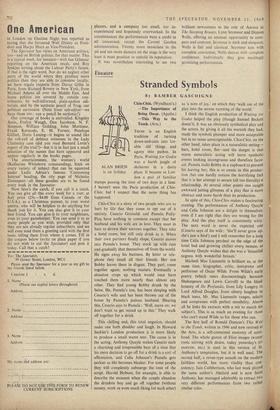Ballet
Defensively Speaking
B y CLIVE BARNES Last week, at the Royalty Theatre, in the inter- val of that interminable Evening with Zizi Jeanmaire, one of the cleverest women journal- ists in the country told me: 'I loathe ballet, except for Jerome Robbins, of course.' Now this remark is about as sensible as 'I loathe drama (music) (art) (what-have-you), except for Bertolt Brecht (Anton Webern) (Paul Klee) (who-have-you), of course'; but my heart went out to her. If I judged dancing largely by what I saw outside specifically dance performances, I too would treat most of it with nothing but contempt. (That I also feel dissatisfied with a great deal of the actual ballet produced is quite beside the point. It is only when I see ridicu- lously sub-standard ballet ticketed as typical that I become belligerently defensive.) Having had my special plead, let me say that the Jeanmaire show is entirely diverting—for its last thirty minutes of pure cabaret. When Jeanmaire starts to sing with all the osprey- feather naughtiness that is France's most cele- brated export, all is right with the world, ex- cept for one's memories. But those memories by , then include a day-long film of Paris, an un- pleasant little dance number for five boys, three other boys who seemed watery brothers of Les Freres Jacques and Marcel Marceau, a loud but thinly spread jam session of jazz through the ages, and the 'world premiere of a ballet' loosely based by Roland Petit on Somerset Maugham's story, Rain. To see the supple-legged Jeanmaire, a dancer I have adored since her London debut in 1946, emoting her way urchin-facedly through this shabbily artificial charade about a clergy- man and a whore could have been sad, but was merely boring.
The Indian dancer Indrani, direct, as they say, from her triumphs in America, called in at St. Pancras Town Hall last week on her way back to New Delhi. Accompanied by four musicians and three partners, including 'the bull- throated dance-actor Narasimha Rao, she gave a programme of classical Indian dancing full of the very quality that the first part of the Jean- maire show, for all its striving, lacked—enter- tainment. Admittedly classical temple dances would make a somewhat formidable mass enter- tainment medium, but these miniature dance dramas of Hindu mythology, told with fluttering hands and wildly gesticulating eyeballs, have a unique fascination.
When is the Royal Ballet not the Royal Ballet is an unkind riddle of significance to all ballet- goers living in the British provinces. The Royal Ballet company, which is at present on tour, offers more or less the Covent Garden reper- tory, but hardly to Covent Garden standards. The resources of this company are quite, in- adequate for the job, it, is attempting. Last week in Oxford it tried to produce The Sleeping Beauty with an orchestia of about thirty indifferent players, and a company too small, too in- experienced and hopelessly overworked. In the circumstances the performances were a credit to all concerned, except the Covent Garden administration. Twenty more musicians in the pit and ten more dancers on the stage is the very least it must produce to uphold its reputation.
It was nevertheless interesting to see two brilliant newcomers to the role of Aurora in The Sleeping Beauty, Lynn Seymour and Doreen Wells, offering an unusual opportunity to com- pare and contrast. Seymour is dark and eloquent, Wells is fair and classical. Seymour acts with complete conviction, Wells dances with complete confidence. Individually they give excitingly promising performances.















































 Previous page
Previous page